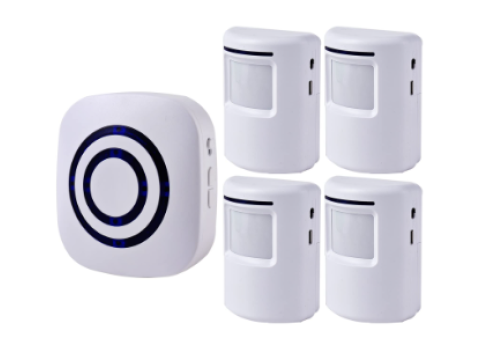Why Choose a Wireless Motion Detector?
Wireless motion sensors (often infrared-based) have become a go-to option in modern security design. By eliminating cables, you’ll enjoy simpler installation, a more discreet appearance, and greater flexibility in sensor placement—both indoors and outdoors. Although you can’t fully conceal a motion detector (the lens must remain unobstructed for reliable performance), a wireless setup helps you achieve a more seamless, low-profile installation. Below, we explain the key features of these devices, including GSM compatibility and outdoor (perimeter) sensors.
Types of Wireless Infrared Motion Sensors
Active IR Sensors
- Two-Unit Construction: These come as a transmitter (emitter) and a receiver. When a person or object crosses the IR beam, the receiver detects a drop in intensity and triggers an alarm signal.
- Beam/Liner Coverage: Ideal for perimeter protection around open outdoor spaces—like fences or property lines.
Passive IR (PIR) Sensors
- Single Module: Monitors changes in ambient infrared radiation. As someone moves through the protected zone, the IR intensity in those sectors shifts.
- Detection Zones:
- Volumetric (wide range, often used indoors)
- Surface (a “curtain” zone for windows or narrow hallways)
- Linear (a tightly focused beam)
- Best for Indoor Use: Typically have shorter ranges but are well-suited for homes and apartments.
Wireless Motion Sensors in GSM Alarm Systems
Wireless GSM alarms typically come with dedicated, fully compatible sensors. That’s because each manufacturer sets specific:
- Radio Frequencies
- Communication Protocols
If you already have a wired GSM system installed but want to add wireless motion detectors, you’ll need a radio receiver module (RRM) that matches the sensors’ frequency and protocol. You can then connect the RRM’s relay outputs to your existing GSM control panel. A popular option is the Astra RI-M line of devices, which pairs a compatible receiver with wireless motion detectors.
Tip: Wireless systems require setup and programming. Ensure you follow the manual for pairing and calibrating each device.
Best Practices for Installing Wireless Infrared Sensors
- Stable Mounting
- Always secure the motion detector on a firm wall or post to avoid false alarms caused by vibrations.
- Avoid Direct Bright Light
- Strong headlights or sunlight can overwhelm an IR sensor.
- Limit Hot/Cold Air Flows
- Keep them away from heating vents or air conditioners, which may create convection currents and trigger false alarms.
- Recommended Height
- Mount the sensor at the height advised by the manufacturer (commonly 6.5–8 feet).
Outdoor & Perimeter Motion Detectors
While wireless IR sensors excel indoors, certain outdoor models exist for perimeter surveillance. However, weather elements (rain, fog, snow) can scatter IR beams, leading to decreased reliability. For large perimeters, consider:
- Active IR “Beam” Sensors: Create a linear detection zone spanning tens of yards. If an intruder crosses the beam, the alarm fires.
- Volumetric Outdoor Sensors: Detect movement across an open area rather than just a line. Ideal for monitoring yards, patios, or parking lots.
Weather Considerations for Outdoor IR Sensors
- Rain & Fog: Water particles can absorb or scatter IR signals, creating blind spots or false triggers.
- Temperature Swings: Rapid changes in ambient temperature can also cause instability.
- Sun Glare: Direct sunlight may saturate the sensor’s lens.
Because of these challenges, some installers use microwave (RF) outdoor detectors instead. These devices send high-frequency radio waves, then measure the Doppler shift if a moving object reflects back a changed signal. Microwave sensors are less affected by harsh weather and can more reliably identify intruders—however, they’re often more expensive.
Minimizing False Alarms in Outdoor Spaces
Outside, many non-intrusion elements—birds, pets, tree branches—can trigger motion detectors. To reduce these false alarms:
- Cleared Zone
- Maintain a buffer area (like a “no-plants zone”) around the perimeter.
- Additional Fencing
- Keep large animals or passersby away from direct sensor lines.
- Multi-Beam Sensors
- Systems using multiple IR or microwave beams are more discerning, requiring simultaneous breaks in several beams before triggering an alarm.
Premium IR Outdoor Sensors (e.g., Tower 20AM PG2) use multiple pyro detectors—each covering a specific sector. The device’s onboard algorithms filter out environmental conditions such as rain, direct sunlight, and small animals.
Note on Cost: High-grade outdoor wireless sensors can be pricey—often around $200–$300 or more. It’s worth calculating whether the investment meets your security needs and budget.
Conclusion
A reliable wireless motion sensor for indoor or outdoor use may cost more than wired alternatives, but the benefits of easier installation, flexible positioning, and sleek design often outweigh the premium. For outdoor perimeter surveillance, carefully weigh infrared vs. microwave options, factoring in local weather conditions, false-alarm potential, and your overall security requirements.
- Indoors: Infrared (PIR) sensors are common, affordable, and effective for living areas.
- Perimeters / Outdoors: Active IR beams or microwave sensors might be a better fit, offering stronger resistance to weather and fewer false triggers.
Finally, ensure the device seamlessly integrates with your existing GSM alarm platform. If your GSM system was initially wired-only, you can still add wireless sensors via a compatible receiver unit—just make sure they share the same radio frequency and protocol. For more guidance and product recommendations, check out safsale.com, where we connect you with top-notch security solutions tailored to your property’s unique needs.

